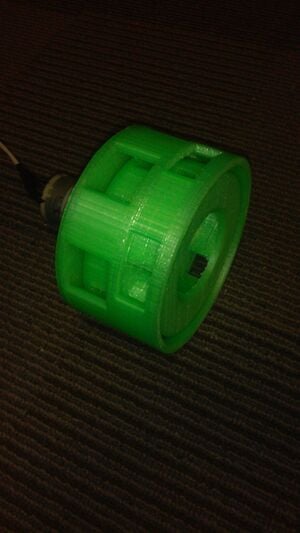
This is a 3D printed Security Siren that could be used in low income areas where theft or other problems are an issue. The purpose of the siren is to get the attention of others nearby when a crime or other emergency is happening. Because crime rates are sometimes higher in lower income areas it would be beneficial to provide a low cost alternative to these areas.
This siren has a 5:6 frequency ratio, also known as a untempered minor third. Having two clashing tone simultaneously makes the siren more noticeable.
This has been improved from other designs, having fewer parts for ease of assembly, using an electric motor rather than a hand crank ed siren, and by having 2 tones instead of 1
Bill of Materials[edit | edit source]
Non-Printed parts
- 2 X 3mm dia X 10 mm length fine thread socket cap screws ~ $0.66 total
- 2 X 3mm dia split lock washers ~ $0.50 total
- 13.6 V 6290 RPM Johnson electric motor part number: 9167AJ ~ $3.95
- 12 V 4 amp AC-DC power supply ~ $2.99
- 2mm hex wrench ~ $0.30
Printed Parts
- Stator ~ $5
- Rotor ~ $6
Total Cost ~ $19
Source and STL files[edit | edit source]
The STL files are available on thingaverse, here is the link:
http://www.thingiverse.com/thing:1183185
Tools needed[edit | edit source]
- 3-D printer, I used the Athena: MOST Delta RepRap3-D printer
- 2mm hex wrench
- Wire stripper or something to strip wires safely
Skills and knowledge needed[edit | edit source]
- soldering
Technical Specifications and Assembly Instructions[edit | edit source]
- Stator print time estimate ~ 5 hours
- Rotor print time estimate ~ 5 hours
- Include assembly time estimate - 30 minutes
To assemble:
- Print stator and rotor
- Cut and solder power supply wires as show in picture
- inset motor into hole in stator and secure with screws and lock washers using the 2mm hex wrench
- Insert motor shaft into rotor. This is a pres fit onto a spline shaft, so it will require a bit of force, make sure to push the rotor on straight as shown in picture.
Common Problems and Solutions[edit | edit source]
- Include common mistakes/problems to avoid in building your OSAT and how to overcome them
- Make sure to tighten screw snugly onto lock washers so they don't come loose from vibration
- Make sure to push the rotor straight onto the motor shaft, or the hole might get damaged and the rotor could be off center and unbalanced
Cost savings[edit | edit source]
- If your solution is not a low cost one then it is not really appropriate.
- Estimate your costs: Approximately 390 g pla (~ $11), cost of non-printed parts (~ $8) = Total: $19
- Similar sized air raid style sirens were anywhere from $35.15 to $89.99
- This means percent savings is somewhere between 46% and 79%